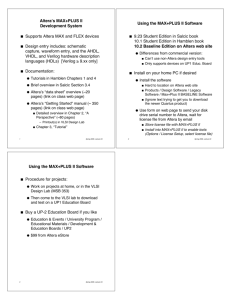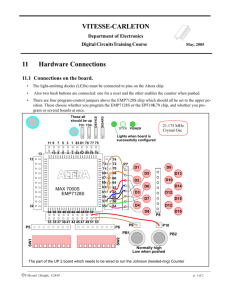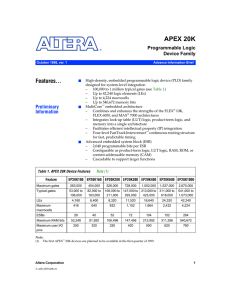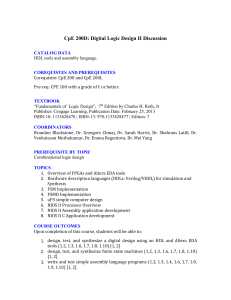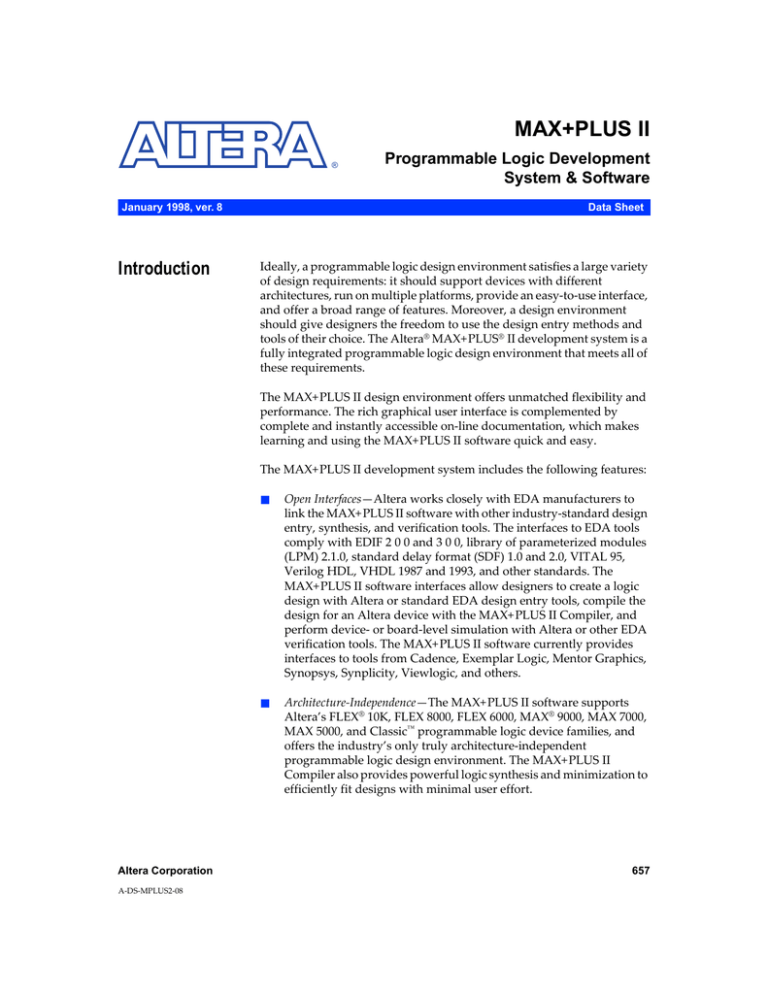
MAX+PLUS II
®
January 1998, ver. 8
Introduction
Programmable Logic Development
System & Software
Data Sheet
Ideally, a programmable logic design environment satisfies a large variety
of design requirements: it should support devices with different
architectures, run on multiple platforms, provide an easy-to-use interface,
and offer a broad range of features. Moreover, a design environment
should give designers the freedom to use the design entry methods and
tools of their choice. The Altera® MAX+PLUS® II development system is a
fully integrated programmable logic design environment that meets all of
these requirements.
The MAX+PLUS II design environment offers unmatched flexibility and
performance. The rich graphical user interface is complemented by
complete and instantly accessible on-line documentation, which makes
learning and using the MAX+PLUS II software quick and easy.
The MAX+PLUS II development system includes the following features:
Altera Corporation
A-DS-MPLUS2-08
■
Open Interfaces—Altera works closely with EDA manufacturers to
link the MAX+PLUS II software with other industry-standard design
entry, synthesis, and verification tools. The interfaces to EDA tools
comply with EDIF 2 0 0 and 3 0 0, library of parameterized modules
(LPM) 2.1.0, standard delay format (SDF) 1.0 and 2.0, VITAL 95,
Verilog HDL, VHDL 1987 and 1993, and other standards. The
MAX+PLUS II software interfaces allow designers to create a logic
design with Altera or standard EDA design entry tools, compile the
design for an Altera device with the MAX+PLUS II Compiler, and
perform device- or board-level simulation with Altera or other EDA
verification tools. The MAX+PLUS II software currently provides
interfaces to tools from Cadence, Exemplar Logic, Mentor Graphics,
Synopsys, Synplicity, Viewlogic, and others.
■
Architecture-Independence—The MAX+PLUS II software supports
Altera’s FLEX® 10K, FLEX 8000, FLEX 6000, MAX® 9000, MAX 7000,
MAX 5000, and Classic™ programmable logic device families, and
offers the industry’s only truly architecture-independent
programmable logic design environment. The MAX+PLUS II
Compiler also provides powerful logic synthesis and minimization to
efficiently fit designs with minimal user effort.
657
MAX+PLUS II Programmable Logic Development System & Software Data Sheet
658
■
Multiple Platforms—The MAX+PLUS II software runs on
Windows NT 3.51 or 4.0, Windows 95, or 486- or Pentium-based PCs,
and on Sun SPARCstations, HP 9000 Series 700/800, and
IBM RISC System/6000 workstations.
■
Full Integration—The MAX+PLUS II software design entry,
processing, and verification features offer the most fully integrated
suite of programmable logic development tools available, allowing
faster debugging and shorter development cycles.
■
Modular Tools—Designers can customize their development
environment by choosing from a variety of design entry,
compilation, verification, and device programming options, all of
which are described in this data sheet. Additional features can be
added as needed, preserving the initial tools investment. Because
the MAX+PLUS II software supports multiple device families,
designers can add support for new architectures without having to
learn new tools.
■
Hardware Description Languages (HDLs)—The MAX+PLUS II software
supports a variety of HDL design entry options, including VHDL,
Verilog HDL, and the Altera Hardware Description Language
(AHDL).
■
MegaCore™ Functions—MegaCore functions are pre-verified HDL
netlists files for complex system-level functions and are optimized
for FLEX 10K, FLEX 8000, FLEX 6000, MAX 9000, and MAX 7000
devices. Created by Altera, MegaCore functions reduce the design
task to creating only the custom logic surrounding commonly used
system-level functions, which permits designers to focus more time
and energy on improving and differentiating the design and final
product.
■
OpenCore™ Feature—The MAX+PLUS II software provides the
OpenCore feature, which allows designers to evaluate
megafunctions prior to licensing.
Altera Corporation
MAX+PLUS II Programmable Logic Development System & Software Data Sheet
MAX+PLUS II
Design Process
The MAX+PLUS II design process, shown in Figure 1, consists of four
phases: design entry, design compilation, design verification, and device
programming.
Figure 1. MAX+PLUS II Design Environment
Design Entry
Design Compilation
Cadence
Mentor Graphics
edif
Synopsys
Standard Viewlogic
Synplicity
EDA
Exemplar Logic
Design
Others
Verification & Programming
edif
MAX+PLUS II Compiler
Standard
EDA
Verification
Cadence
Mentor Graphics
Synopsys
Viewlogic
Others
Entry
abcde
abc
abcd
Graphic
Design Entry
Design-Rule
Checking
Timing
Simulation
Text Design Entry
(AHDL, VHDL, & Verilog HDL)
Logic
Synthesis &
Fitting
Functional
Simulation
Multi-Device
Partitioning
Multi-Device
Simulation
Waveform
Design Entry
Automatic
Error
Location
Timing
Analysis
Hierarchical
Design Entry
TimingDriven
Compilation
Device
Programming
Floorplan
Editing
OpenCore
Evaluation
OpenCore
Evaluation
High-Level MegaCore Functions
LPM Functions
Design
AMPP Megafunctions
Entry
Design Entry
The MAX+PLUS II software can integrate multiple design files—
generated with MAX+PLUS II design entry tools or with a variety of other
industry-standard EDA design entry tools—into a single design
hierarchy. The extensive integration between MAX+PLUS II applications
allows information to flow freely to and from each application. For
example, any errors identified during compilation, simulation, and
timing analysis can be automatically located and highlighted in the
original design file or in the Floorplan Editor. If a design (called a
“project” in the MAX+PLUS II software) consists of two or more levels of
hierarchy, the user can navigate from one design file directly to any other
design file in the hierarchy, regardless of whether it is graphic-, text-, or
waveform-based.
Altera Corporation
659
MAX+PLUS II Programmable Logic Development System & Software Data Sheet
MegaCore Functions
Altera MegaCore functions support applications such as peripheral
component interconnect (PCI) and other bus interfaces, digital signal
processing (DSP), and communications. These functions can be
instantiated into designs and simulated with the MAX+PLUS II
development system or any Altera-supported EDA tool. For
MAX+PLUS II design flows, the designer simply instantiates the function
in the design file. For design files that use third-party EDA tools,
designers can instantiate MegaCore functions by specifying the function
and port names in the hardware description language (HDL) design file.
During design processing, the EDA tool includes the function in an EDIF
netlist file. The MAX+PLUS II software compiles the resulting EDIF netlist
file for the desired Altera device architecture.
MegaCore
TM
Table 1 describes currently available Altera MegaCore functions.
Table 1. MegaCore Functions
Applications
Description
Target Devices
PCI
PCI bus with internal direct memory access function. Zero-wait
state burst-mode operation at 33 MHz.
EPF10K30
EPF10K20
DSP/fast Fourier
transform (FFT)
Fully parameterizable fast Fourier transform function.
FLEX 10K
Video/color space
converter
RGB2YCrCb and YCrCb2RGB color space converters.
FLEX 10K
FLEX 8000
FLEX 6000
Communications/error
checking
Cyclic redundancy code generator and checker.
FLEX 10K
FLEX 8000
FLEX 6000
Microperipheral library
Programmable DMA controller, interrupt controller, programmable
communications interface, programmable peripheral interface
adapter, universal asynchronous receiver/transmitter (UART), and
asychronous communications interface adapter.
FLEX 10K
FLEX 8000
FLEX 6000
MAX 9000
MAX 7000
Altera also provides a wide variety of megafunctions through the Altera
Megafunction Partners Program (AMPP). Like Altera, AMPPSM partners
develop megafunctions that are optimized for Altera devices and can also
facilitate high-density design. Over 50 AMPP megafunctions that serve a
broad range of digital signal processing (DSP), communications, bus
interface, and other applications are available.
f
660
For more information on Altera MegaCore or AMPP megafunctions, see
Introduction to Megafunctions in this data book or go to the Altera worldwide web site at http://www.altera.com.
Altera Corporation
MAX+PLUS II Programmable Logic Development System & Software Data Sheet
OpenCore Feature
OpenCore
TM
f
MegaCore or AMPP megafunctions can be previewed before licensing via
the MAX+PLUS II OpenCore feature. This pre-purchase evaluation
system allows designers to instantiate and simulate MegaCore functions
or AMPP megafunctions. However, programming files as well as output
files for third-party EDA tool simulation can only be generated with an
authorization code provided upon licensing.
For information of the OpenCore feature, see Introduction to Megafunctions
in this data book, or go to MAX+PLUS II Help, or refer to the Altera web
site.
Industry-Standard LPM Functions
Users can create designs using functions from the industry-standard
LPM version 2.1.0. The LPM offers scalable logic functions—such as
RAM, counters, adders, and multiplexers—and preserves high-level
design information for optimal implementation. The MAX+PLUS II
Compiler automatically generates optimized, architecture-specific
implementations of LPM functions. LPM functions can be implemented
with industry-standard design entry tools, or in schematic or text designs
created with the MAX+PLUS II software.
edif
LPM
f
For more information on LPM functions, refer to the LPM Quick
Reference Guide or MAX+PLUS II Help, or go to the Altera web site.
Industry-Standard EDA Design Entry
The MAX+PLUS II Compiler interfaces with industry-standard EDA tools
that generate EDIF 2 0 0 and 3 0 0 netlist files, including files that contain
LPM functions. The Compiler uses Library Mapping Files (.lmf) to map
symbol and pin names from other EDA tools to MAX+PLUS II logic
functions. Altera supports the use of LMFs with tools from companies
such as Cadence, Mentor Graphics, Viewlogic, and others. VHDL 1987
and 1993 and Verilog HDL design support is also available from Cadence,
Exemplar Logic, Mentor Graphics, Synopsys, Synplicity, and others.
edif
f
Altera Corporation
For more information on other EDA tool vendors, see EDA Software
Support in this data book.
661
MAX+PLUS II Programmable Logic Development System & Software Data Sheet
Schematic Capture & Symbol Editing
The MAX+PLUS II Graphic Editor, shown in Figure 2, makes schematic
design entry fast and easy. The Graphic Editor allows a designer to create
and edit a Graphic Design File (.gdf) that includes a combination of
megafunctions, macrofunctions, and primitive symbols. The
MAX+PLUS II software provides over 300 74-series, LPM, and custom
functions.
abcde
The MAX+PLUS II software allows a designer to automatically create a
symbol for any design file. With the Symbol Editor (also shown in
Figure 2), the designer can modify a symbol to customize its appearance,
or create an entirely new symbol.
Figure 2. MAX+PLUS II Graphic & Symbol Editors
Hardware Description Language (HDL) Entry
The MAX+PLUS II Text Editor is ideal for entering and editing HDL
design files written in VHDL 1987 and 1993, Verilog HDL, or AHDL. The
MAX+PLUS II Compiler can synthesize logic from any of these languages
and map it to any of Altera’s FLEX, MAX, and Classic device families.
662
Altera Corporation
MAX+PLUS II Programmable Logic Development System & Software Data Sheet
HDLs can implement state machines, truth tables, conditional logic,
Boolean equations, and arithmetic operations—including addition,
subtraction, equality and magnitude comparison. The MAX+PLUS II
software also supports LPM functions entered in HDLs. Together, these
features make it easy to implement complex projects in a concise, highlevel description.
Waveform Design Entry
The MAX+PLUS II Waveform Editor (shown in Figure 3) is used to create
and edit waveform design files, as well as input vectors for simulation and
functional testing. The Waveform Editor also functions as a logic analyzer
that allows the designer to view simulation results.
Figure 3. MAX+PLUS II Waveform Editor
Waveform design entry is best suited for sequential and repeating
functions. The Compiler’s advanced waveform synthesis algorithms
automatically generate logic from user-defined input and output
waveforms that represent registered, combinatorial, and state machine
logic. The Compiler automatically assigns state bits and state variables for
state machines.
Altera Corporation
663
MAX+PLUS II Programmable Logic Development System & Software Data Sheet
The Waveform Editor allows the designer to copy, cut, paste, repeat, and
stretch waveforms; to create design files with internal nodes, flipflops,
state machines, and memory words; to combine waveforms into groups
that display binary, octal, decimal, or hexadecimal values; to compare two
sets of simulation results by superimposing one set of waveforms on
another; and to annotate files with comments.
Floorplan Editing
The MAX+PLUS II Floorplan Editor (shown in Figure 4) simplifies the
process of assigning logic to device pins and logic cells. A graphical image
of each device used in a project allows easy logic placement. Both highlevel and detailed device views are available. The designer can assign pins
and logic cells before compiling a design, and can view and modify the
results after compilation.
Floorplan Editor features allow the designer to view all assigned and
unassigned logic in a device. The Floorplan Editor provides a color-coded
view of all logic resources in the device, as well as user assignments, fan-in
and fan-out information, and architecture-specific features. Any node or
pin can be dragged to a new location. Logic can be assigned to specific
pins and logic cells, or to more general regions within a device.
Assignments can also be made with menu commands in any
MAX+PLUS II application. All assignments are stored in the text-based
Assignment & Configuration File (.acf), which can also be edited in the
MAX+PLUS II Text Editor.
664
Altera Corporation
MAX+PLUS II Programmable Logic Development System & Software Data Sheet
Figure 4. MAX+PLUS II Floorplan Editor
Hierarchical Design Entry
Hierarchical designs can consist of design files created using several
different methods, including schematic capture, HDL design entry,
waveform design entry, and industry-standard netlist files. The
MAX+PLUS II software supports multiple levels of hierarchy in a single
design. This flexibility allows designers to use the design entry method
best suited to each portion of the design. The MAX+PLUS II Hierarchy
Display, which displays the hierarchical structure of a project, allows
designers to traverse the hierarchy easily, automatically opening the
appropriate editor for each design file. See Figure 5.
Altera Corporation
665
MAX+PLUS II Programmable Logic Development System & Software Data Sheet
Figure 5. MAX+PLUS II Hierarchy Display
Design Compilation
When the MAX+PLUS II software processes a design, the MAX+PLUS II
Compiler reads in design files and produces output files for
programming, simulation, and timing analysis. The Message Processor
can automatically locate errors detected during compilation and find the
source design files for designers. The MAX+PLUS II Compiler can
optimize design files for FLEX 10K, FLEX 8000, FLEX 6000, MAX 9000,
MAX 7000, MAX 5000, and Classic devices.
Message Processor
The MAX+PLUS II Message Processor communicates with all
MAX+PLUS II applications, reporting error, information, and warning
messages for design problems such as connection and syntax errors, as
well as simulation, timing analysis, and programming information.
Designers can use the Message Processor to open the design file that
contains the source of an error and highlight its location automatically. In
addition, the Message Processor can locate errors for the current project in
the Floorplan Editor. See Figure 6.
666
Altera Corporation
MAX+PLUS II Programmable Logic Development System & Software Data Sheet
Figure 6. MAX+PLUS II Compiler & Message Processor
Logic Synthesis & Fitting
The Logic Synthesizer module in the MAX+PLUS II Compiler supports
numerous synthesis options. It selects appropriate logic reduction
algorithms to minimize and remove redundant logic, ensuring that the
device logic resources are used as efficiently as possible for the target
device architecture. It also removes unused logic from the project.
Logic synthesis options help the designer guide the outcome of logic
synthesis. Altera provides three “ready-made” synthesis styles that
specify the settings for multiple logic synthesis options. The designer can
choose a default style to set default synthesis options, create custom
styles, and specify individual synthesis options on selected logic
functions. Synthesis options can be tailored for a specific device family to
take advantage of its architecture. A number of advanced logic options
further expand the designer’s ability to control logic synthesis.
The Compiler’s Fitter module applies heuristic rules to select the best
possible implementation for the synthesized project in one or more
devices. This automatic fitting relieves the designer of tedious place-androute tasks. The Fitter generates a Report File (.rpt) that shows project
implementation as well as any unused resources in the device(s). Fitting
results can also be displayed in the MAX+PLUS II Floorplan Editor.
Altera Corporation
667
MAX+PLUS II Programmable Logic Development System & Software Data Sheet
Timing-Driven Compilation
The Compiler can implement user-specified timing requirements for
propagation delays (t PD), clock-to-output delays (t CO), setup times (t SU),
and clock frequency (f MAX). Designers can specify timing requirements
on selected logic functions and for a project as a whole. The Report File
and Compiler messages provide detailed information on how the timing
requirements have been implemented in the project.
Design-Rule Checking
The MAX+PLUS II Compiler includes the Design Doctor, a design-rule
checker. The Design Doctor checks each design file for logic that may
cause system-level reliability problems that are usually discovered only
after a design has entered production. The user can choose one of three
predefined sets of design rules, or create a custom set of rules.
Design rules are based on reliability guidelines that cover potential design
problems such as asynchronous inputs, ripple clocks, multi-level logic on
clocks, preset and clear configurations, and race conditions. Rule
violations are explained to help the designer determine which edits are
needed in the design files.
Multi-Device Partitioning
If a project is too large to fit in a single device, the Compiler’s Partitioner
module divides it into multiple devices from the same device family. The
Partitioner attempts to split the project into the fewest possible number of
devices while minimizing the number of pins used for inter-device
communication. The Fitter automatically fits the logic into the specified
devices.
Partitioning can be totally automatic, partially user-controlled, or fully
user-controlled. If a project is too large to fit into the target device, the
designer can specify the type and number of additional devices.
Industry-Standard Simulation Formats
The MAX+PLUS II Compiler can create netlist files for use in a variety of
simulation environments. These netlist files contain post-synthesis
functional and timing information that can be used with standard design
verification tools for device- or board-level simulation.
668
Altera Corporation
MAX+PLUS II Programmable Logic Development System & Software Data Sheet
The following interfaces are available:
Interface:
MAX+PLUS II Software Support:
EDIF
Creates EDIF 2 0 0 and 3 0 0 netlist files that provide
functionality and timing for third-party simulators.
Verilog HDL
Creates Verilog HDL netlist files that can be used with
Verilog HDL simulators.
VHDL
Creates VHDL 1987 and 1993 netlist files that can be used
with VHDL simulators.
For each interface, the Compiler can optionally generate a version 1.0 or
2.1 Standard Delay Output Format File (.sdo) that includes timing
information for simulators that require timing and functional information
in separate files.
Programming File Generation
Both the MAX+PLUS II Compiler and Programmer can generate
programming files. The following programming file formats are available
in the MAX+PLUS II software:
■
■
■
■
■
■
■
■
■
■
■
f
Programmer Object File (.pof)
FLEX Chain File (.fcf)
SRAM Object File (.sof)
JEDEC File (.jed)
JTAG Chain File (.jcf)
Hexadecimal (Intel-format) File (.hex)
Tabular Text File (.ttf)
Raw Binary File (.rbf)
Serial Bitstream File (.sbf)
Serial Vector Format (.svf) files
Jam™ File (.jam)
For more information on programming and configuring devices with
these file formats, go to MAX+PLUS II Help.
Design Verification
The MAX+PLUS II software offers design verification capabilities—
including design simulation and timing analysis—that test the logical
operation and internal timing of a design. Design verification tools for
Altera devices are also available from a variety of EDA vendors.
Altera Corporation
669
MAX+PLUS II Programmable Logic Development System & Software Data Sheet
Simulation
The MAX+PLUS II Simulator provides flexibility and control for
modeling single- or multi-device projects. The Simulator uses Simulator
Netlist Files (.snf) that are generated during compilation to perform
functional, timing, or multi-device simulation for a project. Figure 7
shows the MAX+PLUS II Simulator.
Figure 7. MAX+PLUS II Simulator
The designer either defines input stimuli with a straightforward vector
input language or draws waveforms directly with the MAX+PLUS II
Waveform Editor. Simulation results can be viewed in the Waveform
Editor or Text Editor and printed as waveform or text files.
The designer specifies commands either interactively or in a text-based
command file to perform a variety of tasks, such as monitoring the project
for glitches, oscillation, and register setup and hold time violations;
halting the simulation when user-defined conditions are met; forcing
flipflops high or low; performing functional testing; and defining the
initial memory content of RAM or ROM blocks. If a setup or hold time,
minimum pulse width, or oscillation period is violated, the Message
Processor reports the problem. The designer can then use the Message
Processor to locate the time at which the problem occurred in the
Waveform Editor and to locate the error in the original design file.
670
Altera Corporation
MAX+PLUS II Programmable Logic Development System & Software Data Sheet
For easy comparison, the designer can superimpose the results of
two simulations in the Waveform Editor.
Functional Simulation
The MAX+PLUS II Simulator supports functional simulation to test
the logical operation of a project before it is synthesized, thereby
allowing the designer to quickly identify and correct logical errors.
The MAX+PLUS II Waveform Editor displays the results of
functional simulation and provides easy access to all nodes in the
project, including combinatorial functions.
Timing Simulation
In a timing simulation, the MAX+PLUS II Simulator tests the project
after it has been fully synthesized and optimized. Timing simulation
is performed at 0.1-ns resolution.
Multi-Device Simulation
The MAX+PLUS II software can combine the timing and/or
functional information from multiple Altera devices, allowing the
designer to simulate several devices operating together. Devices
from different Altera device families can be used in the same project.
Timing Analysis
The MAX+PLUS II Timing Analyzer can calculate a matrix of pointto-point device delays, determine setup and hold time requirements
at device pins, and calculate maximum clock frequency.
MAX+PLUS II design entry tools are integrated with the Timing
Analyzer, allowing the designer to simply tag start and end points in
the design files or the Floorplan Editor to determine the shortest and
longest propagation delays. In addition, the Message Processor can
locate and display critical paths identified by the Timing Analyzer in
the source design files or in the Floorplan Editor. See Figure 8.
Altera Corporation
671
MAX+PLUS II Programmable Logic Development System & Software Data Sheet
Figure 8. MAX+PLUS II Timing Analyzer
Device Programming
The MAX+PLUS II Programmer, shown in Figure 9, uses programming
files to program Altera devices. The Programmer allows the designer to
program, verify, examine, blank-check, and functionally test devices.
Altera provides all hardware and software necessary for programming
and verifying devices, including a Logic Programmer Card, Master
Programming Unit (MPU), and programming adapters. The add-on Logic
Programmer card (for PCs or compatible computers) drives the MPU. The
MPU performs continuity checking to ensure adequate electrical contact
between the programming adapter and the device. With the appropriate
programming adapter, the MPU also supports functional testing, so that
vectors created for simulation can be applied to a programmed device to
verify its functionality.
672
Altera Corporation
MAX+PLUS II Programmable Logic Development System & Software Data Sheet
Figure 9. MAX+PLUS II Programmer
Altera also provides the ByteBlaster™ parallel port download cable, and
the BitBlaster™ serial download cable for device programming and
configuration. The ByteBlaster download cable connects to a DC parallel
port and the BitBlaster download cable connects to a standard PC or
UNIX workstation RS-232 port to provide configuration/programming
data. With the BitBlaster or ByteBlaster download cables, designers can
also configure or program multiple devices using the multi-device JTAG
chain mode in the MAX+PLUS II Programmer.
f
For more information on the BitBlaster and ByteBlaster download cables,
Altera programming hardware and software, other programming
hardware manufacturers, and JTAG chain programming and
configuration, refer to the following sources:
■
■
■
■
■
Altera Corporation
ByteBlaster Parallel Port Download Cable Data Sheet in this data book
BitBlaster Serial Download Cable Data Sheet in this data book
Altera Programming Hardware Data Sheet in this data book
Programming Hardware Manufacturers in this data book
“Setting Up Multi-Device JTAG Chains” in MAX+PLUS II Help
673
MAX+PLUS II Programmable Logic Development System & Software Data Sheet
On-Line Help
?
On-line help provides access to all information about the MAX+PLUS II
software. It includes complete, up-to-date documentation on all
MAX+PLUS II applications. Altera-provided primitives, megafunctions,
and macrofunctions; causes and suggested actions for messages;
references to related Altera documentation; text file formats (e.g., AHDL,
Vector Files); and information on Altera devices and adapters.
On-line help is only a keystroke or a mouse click away. The F1 key
provides instant access to information on a dialog box, highlighted menu
command, or pop-up message. Typing Shift+F1 or choosing the contextsensitive help button on the toolbar turns the mouse pointer into a
question mark pointer that allows the designer to click on any item on the
screen—including logic function symbols or names and text file
keywords—for context-sensitive help on that item.
Software
Maintenance
674
The Altera software maintenance program ensures that designers will
receive the latest version of the MAX+PLUS II development software
every quarter. The software maintenance program provides the following
benefits:
■
New Device Support—Altera offers devices with the highest density
and performance in the industry. Altera continues to offer additional
devices by providing additional devices and package options, which
allows designers to create systems with the most advanced devices
and packages.
■
New Software Features—New software features and enhancements
make the MAX+PLUS II software easier to use and improve design
compilation times. Designers with maintenance agreements receive
new features with each MAX+PLUS II upgrade, ranging from HDL
synthesis to improved timing-driven compilation.
■
Programming Methods—MAX+PLUS II supports the latest
programming methods, (e.g., in-system programmability (ISP), incircuit reconfigurability (ICR), and the Jam programming and test
language. Altera continues to enhance its programming hardware
and software to make these programming methods easily accessible.
■
Third-Party EDA Interfaces—The MAX+PLUS II software provides
interfaces to all major EDA design tools as a standard feature. These
interfaces allow designers to work in the most familiar design
environment and implement designs in any Altera device family.
Altera continually enhances the MAX+PLUS II design environment
to keep up-to-date with third-party EDA tool improvements and
upgrades.
Altera Corporation
MAX+PLUS II Programmable Logic Development System & Software Data Sheet
Recommended
System
Configurations
To run the MAX+PLUS II software with optimum results, Altera
recommends the following system configurations:
PC System Configuration
■
■
■
■
■
■
■
■
■
200-MHz Pentium-based or better PC
Available memory as shown in Table 2
Microsoft Windows NT version 3.51 or higher, or Windows 95
Microsoft Windows-compatible graphics card and 17-inch color
monitor
CD-ROM drive
Microsoft Windows-compatible 2-button mouse
Full-length 8-bit slot for the programmer card
Parallel port (i.e., LPT port)
RS-232 serial port for the BitBlaster download cable
Table 2. Memory Requirements for MAX+PLUS II Systems
Device Family
Available Memory (Mbytes)
Physical RAM (Mbytes)
FLEX 10K
256
128
FLEX 8000
64
32
FLEX 6000
64
32
MAX 9000
64
32
MAX 7000
48
16
Sun Ultra 2 SPARCstation System Configuration
■
■
■
■
■
■
Sun Ultra 2 SPARCstation with color monitor
Available memory as shown in Table 2
Sun OpenWindows 3.0 or higher
Solaris 2.5 or higher
ISO 9660-compatible CD-ROM drive
RS-232 serial port for the BitBlaster download cable
HP 9000 Series 700/800 Workstation System Configuration
■
■
■
■
■
■
Altera Corporation
HP 9000 Series 700/800 workstation with color monitor
Available memory as shown in Table 2
HP-UX version 10.20 or higher
HP-VUE
ISO 9660-compatible CD-ROM drive
RS-232 serial port for the BitBlaster download cable
675
MAX+PLUS II Programmable Logic Development System & Software Data Sheet
IBM RISC System/6000 Workstation System Configuration
IBM RISC System/6000 workstation with color monitor
Available memory as shown in Table 2 on page 675
AIX version 4.1 or higher
ISO 9660-compatible CD-ROM drive
RS-232 serial port for the BitBlaster download cable
■
■
■
■
■
1
Software
Package
Options
For the most up-to-date information regarding system
requirements, refer to the MAX+PLUS II read.me file.
Altera offers a variety of tool configurations and add-on migration
products for PC- and UNIX-workstation-based versions of the
MAX+PLUS II software. For more information, go to the Altera web site
at http://www.altera.com.
For up-to-date information on MAX+PLUS II software packages and
development systems, contact your local sales representative or go to the
Altera web site.
676
Altera Corporation
Copyright © 1995, 1996, 1997, 1998 Altera Corporation, 101 Innovation Drive,
San Jose, CA 95134, USA, all rights reserved.
By accessing this information, you agree to be bound by the terms of Altera’s
Legal Notice.

